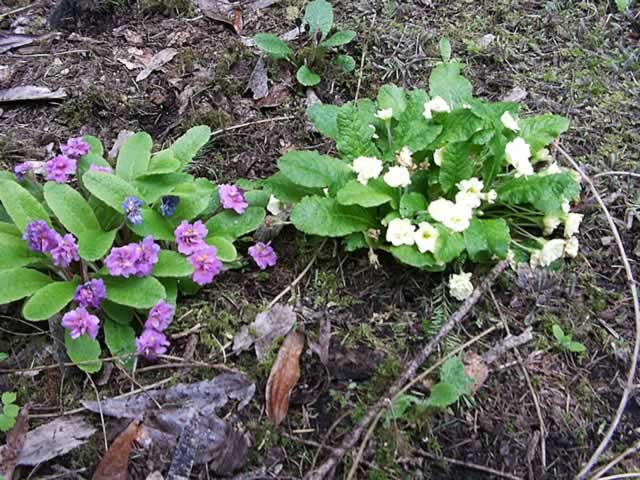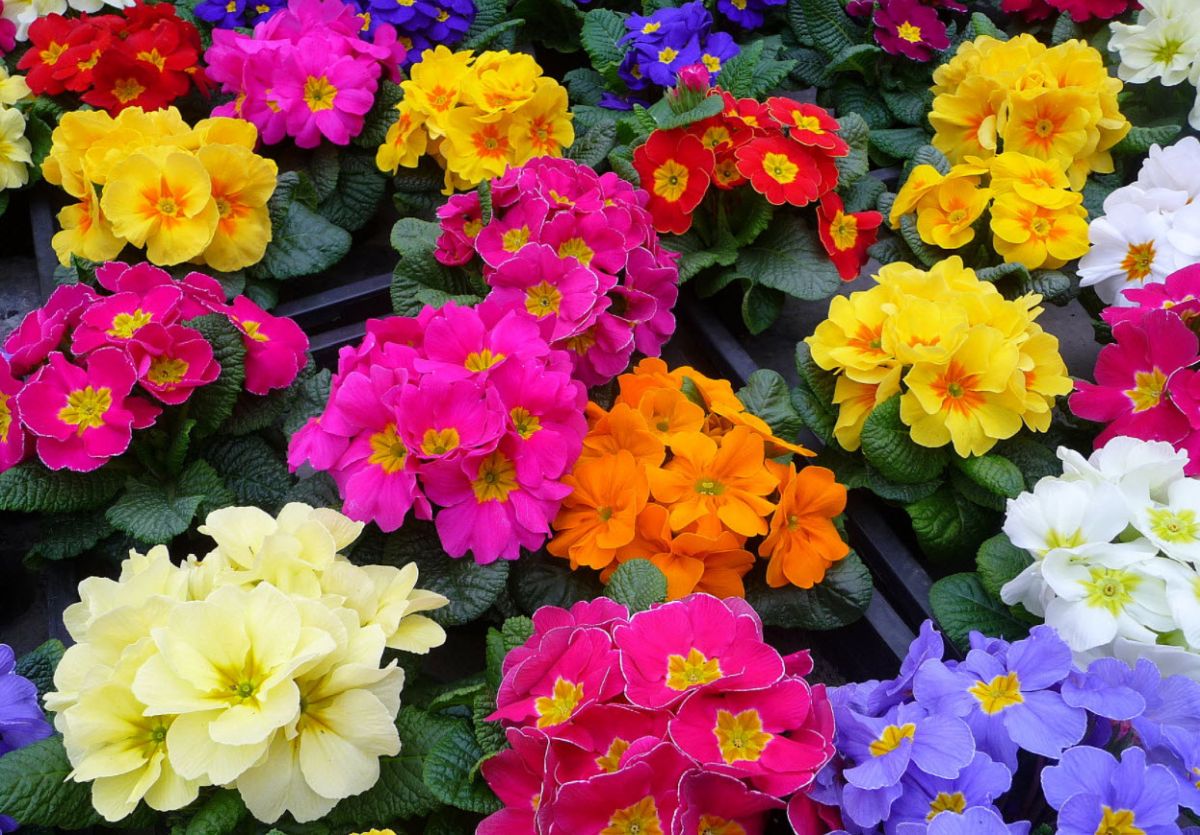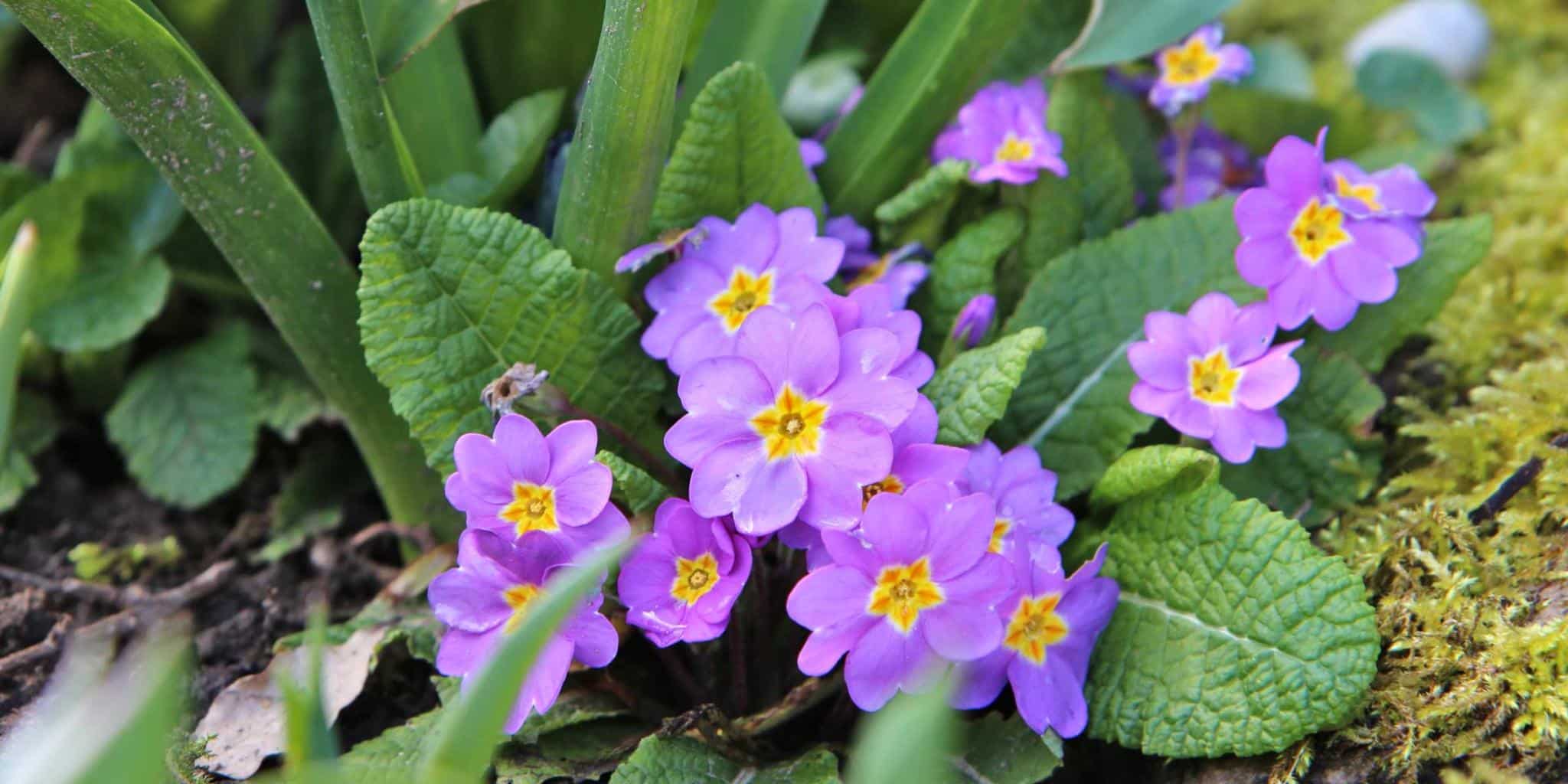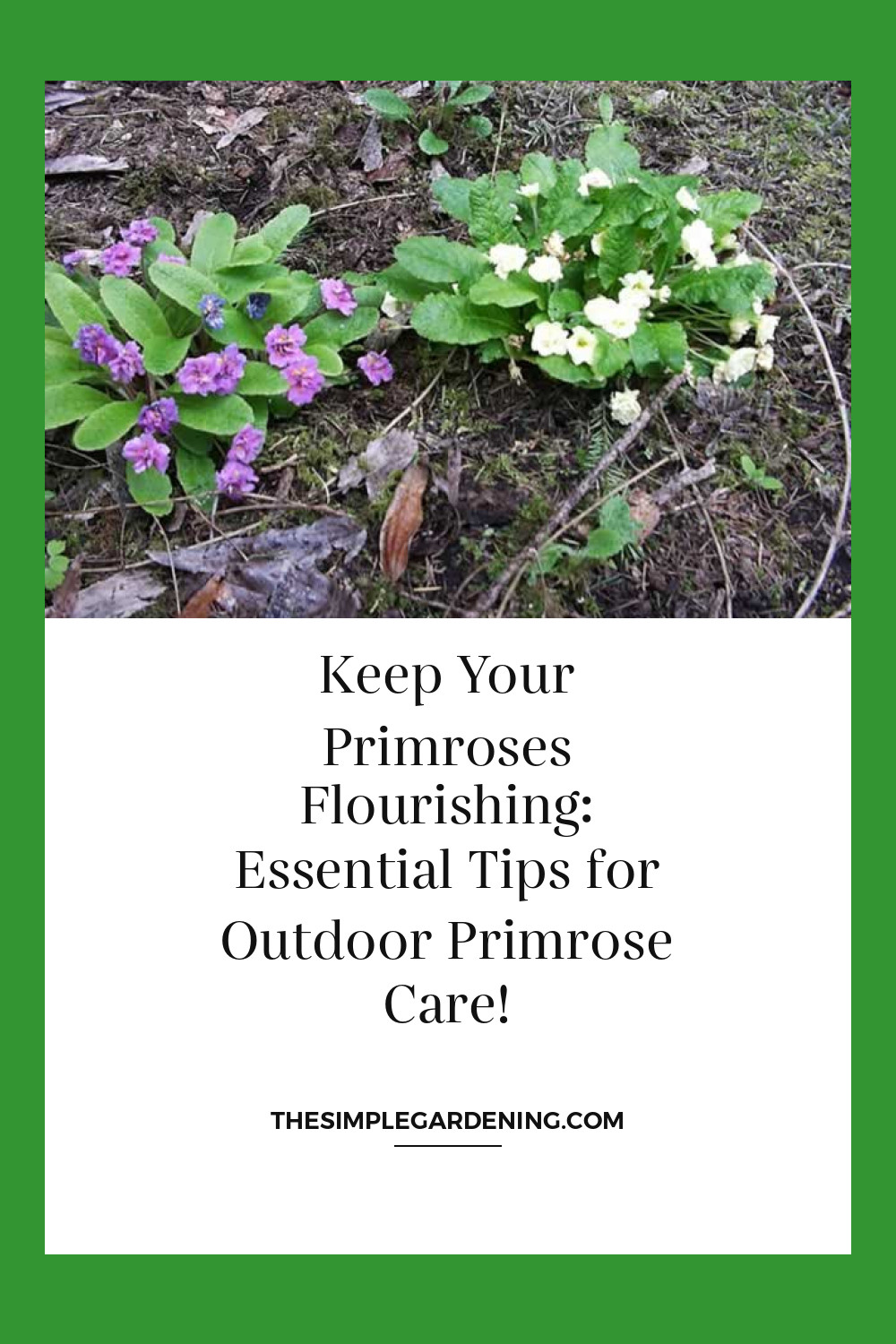
Source Image: www.thegardenhelper.com
IV. Watering Techniques for Outdoor Primroses
Frequency and Amount of Watering
Primroses require consistent moisture, but overwatering can lead to root rot. Water deeply when the soil feels dry to the touch, typically once or twice a week depending on weather conditions.
Table 6: Watering Guidelines for Primrose Varieties
| Variety | Watering Frequency | Amount of Water |
|---|---|---|
| Primula vulgaris | Once or twice a week | 1-2 inches per watering |
| Primula denticulata | Once every 5-7 days | 1 inch per watering |
| Primula japonica | Every 4-6 days | 0.5-1 inch per watering |
Avoiding Overwatering and Waterlogging
To prevent overwatering, ensure proper drainage in the planting area and use a moisture meter to gauge soil moisture levels. Avoid watering the foliage to prevent fungal diseases.
Table 7: Signs of Overwatering in Primroses
| Sign | Description |
|---|---|
| Wilting | Despite adequate moisture, plants appear limp |
| Yellowing leaves | Leaves turn yellow and may drop prematurely |
| Root rot | Foul odor and mushy roots upon inspection |
Point List:
- Water primroses deeply once or twice a week, allowing the soil to dry slightly between waterings.
- Use a moisture meter to monitor soil moisture levels and avoid overwatering.
- Water at the base of the plant to prevent fungal diseases and minimize moisture on the foliage.
V. Mulching for Outdoor Primrose Beds
Benefits of Mulching for Primroses
Mulching conserves soil moisture, suppresses weeds, and regulates soil temperature, creating optimal growing conditions for primroses.
Table 8: Advantages of Mulching for Primrose Beds
| Benefit | Description |
|---|---|
| Moisture retention | Reduces evaporation, keeping soil consistently moist |
| Weed suppression | Prevents weed growth, reducing competition for resources |
| Soil temperature regulation | Insulates soil, protecting roots from extreme temperatures |
Choosing the Right Mulch Material
Opt for organic mulches like shredded bark or compost to enrich the soil as they decompose. Apply a 2-3 inch layer of mulch around primrose plants, keeping it away from the crown to prevent rotting.
Table 9: Types of Mulch for Primrose Beds
| Mulch Material | Description |
|---|---|
| Shredded bark | Natural appearance, breaks down slowly |
| Compost | Rich in nutrients, improves soil structure |
| Pine straw | Lightweight and easy to spread |
Point List:
- Mulching conserves soil moisture, suppresses weeds, and regulates soil temperature, creating optimal growing conditions for primroses.
- Choose organic mulches like shredded bark or compost to enrich the soil and provide nutrients as they decompose.
- Apply mulch in a 2-3 inch layer around primrose plants, ensuring it does not come into direct contact with the crown to prevent rotting.
:max_bytes(150000):strip_icc()/primula-the-primrose-is-no-shy-wallflower-1402858-07-c2741401dbb54bf0bf4994f41553c5c2.jpg)
Source Image: www.thespruce.com
VI. Fertilizing Outdoor Primroses
Types of Fertilizers for Primrose Plants
Primroses benefit from a balanced, slow-release fertilizer formulated for flowering plants. Choose a fertilizer with a higher phosphorus content to promote blooming.
Table 10: Recommended Fertilizers for Primrose Plants
| Fertilizer Type | Description |
|---|---|
| 10-10-10 | Balanced fertilizer with equal parts nitrogen, phosphorus, and potassium |
| 5-10-5 | Higher phosphorus content for enhanced flowering |
| Organic fertilizer | Slow-release, natural nutrients for long-term soil health |
Timing and Frequency of Fertilization
Apply fertilizer in early spring as new growth emerges, and again in mid-summer to support continued blooming. Follow package instructions for application rates.
Table 11: Fertilization Schedule for Primrose Plants
| Time | Activity |
|---|---|
| Early spring | Apply fertilizer as new growth emerges |
| Mid-summer | Apply a second round of fertilizer for continued blooming |
Point List:
- Use a balanced, slow-release fertilizer with a higher phosphorus content to promote blooming in primrose plants.
- Apply fertilizer in early spring as new growth emerges, and again in mid-summer to support continuous flowering throughout the growing season.
- Follow package instructions for proper application rates and avoid over-fertilization, which can lead to nutrient imbalances and plant stress.
VII. Pruning and Deadheading Outdoor Primroses
Removing Spent Flowers for Continued Bloom
Deadheading, or the removal of spent flowers, encourages primrose plants to produce new blooms, extending the flowering period and promoting overall plant health.
Table 12: Benefits of Deadheading Primrose Plants
| Benefit | Description |
|---|---|
| Extended flowering | Promotes the production of new blooms |
| Prevents seed formation | Redirects energy from seed production to blooming |
Pruning to Maintain Shape and Size
Pruning helps maintain the desired shape and size of primrose plants, removing dead or damaged foliage and improving air circulation.
Table 13: Pruning Guidelines for Primrose Plants
| Pruning Task | Timing |
|---|---|
| Deadheading | Throughout the growing season |
| Foliage trimming | As needed to remove dead or damaged leaves |
Point List:
- Deadheading, or the removal of spent flowers, encourages primrose plants to produce new blooms, extending the flowering period and promoting overall plant health.
- Pruning helps maintain the desired shape and size of primrose plants, removing dead or damaged foliage and improving air circulation.
- Perform deadheading throughout the growing season and trim foliage as needed to maintain plant health and appearance.
:max_bytes(150000):strip_icc()/grow-primrose-primula-indoors-1902603-10-8929287b99644be392c278665758017f.jpg)
Source Image: www.thespruce.com
VIII. Protecting Primroses from Pests and Diseases Outdoors
Common Pests and Diseases Affecting Primroses
Primroses can be susceptible to various pests and diseases, including aphids, slugs, powdery mildew, and botrytis. Identifying these issues early allows for prompt treatment and prevention.
Table 14: Common Pests and Diseases of Primrose Plants
| Pest/Disease | Description |
|---|---|
| Aphids | Small, sap-sucking insects that cluster on new growth |
| Slugs | Slimy pests that feed on foliage and flowers |
| Powdery mildew | Fungal disease that appears as white powdery spots on leaves |
| Botrytis | Gray mold that thrives in damp conditions, causing stem and flower rot |
Organic Pest Control Methods
Control pests and diseases using organic methods such as handpicking, neem oil sprays, or natural predators like ladybugs and predatory nematodes.
Table 15: Organic Pest Control Methods for Primrose Plants
| Pest/Disease | Organic Control Method |
|---|---|
| Aphids | Spray with a solution of water and mild dish soap |
| Slugs | Set beer traps or sprinkle diatomaceous earth around plants |
| Powdery mildew | Spray with a solution of water and baking soda |
| Botrytis | Remove infected plant parts and improve air circulation |
Point List:
- Common pests and diseases affecting primroses include aphids, slugs, powdery mildew, and botrytis, which can impact plant health and aesthetics.
- Identify and address pest and disease issues early to prevent them from spreading and causing further damage to primrose plants.
- Utilize organic pest control methods such as handpicking, natural predators, and homemade sprays to manage pest and disease problems while minimizing environmental impact.
IX. Overwintering Outdoor Primroses
Winter Protection Techniques for Primrose Plants
Primroses may need protection during the winter months, especially in colder climates, to prevent frost damage and ensure their survival until spring.
Table 16: Winter Protection Methods for Primrose Plants
| Protection Technique | Description |
|---|---|
| Mulching | Apply a thick layer of mulch around plants to insulate roots from freezing temperatures |
| Covering | Use frost blankets or row covers to shield plants from harsh weather conditions |
| Potted plants | Move potted primroses to a sheltered location or indoors during extreme cold snaps |
Mulching and Insulating to Prevent Frost Damage
Mulching helps regulate soil temperature and insulate primrose roots from freezing temperatures, reducing the risk of frost damage during winter.
Table 17: Benefits of Mulching for Winter Protection
| Benefit | Description |
|---|---|
| Insulation | Mulch acts as a barrier, protecting roots from freezing temperatures |
| Moisture retention | Helps retain soil moisture, preventing dehydration during winter months |
| Weed suppression | Prevents weed growth, reducing competition for resources |
Point List:
- Overwintering primroses involves protecting them from frost damage and harsh winter conditions to ensure their survival until spring.
- Mulching is an effective winter protection technique, insulating primrose roots from freezing temperatures and maintaining soil moisture levels.
- Additionally, covering plants with frost blankets or moving potted primroses indoors during extreme cold snaps can provide added protection against winter weather.
/growing-pink-evening-primrose-5076325-hero-9e96a3f3b2b541f498cfad06169a816f.jpg)
Source Image: www.thespruce.com
Primrose Outdoor Care
X. Supporting Outdoor Primroses with Staking and Trellising
Providing Support for Tall or Leggy Primrose Varieties
Tall or leggy primrose varieties may require additional support to prevent flopping or bending under their own weight, especially during periods of heavy rain or wind.
Table 18: Support Options for Tall Primrose Varieties
| Support Structure | Description |
|---|---|
| Stakes | Insert stakes into the ground and tie stems to them using soft ties or twine |
| Trellises | Install trellises behind primrose plants to provide vertical support |
Choosing the Right Support Structures
Select support structures that are sturdy yet flexible, allowing room for plant growth while providing adequate support to prevent bending or breakage.
Table 19: Factors to Consider When Choosing Support Structures
| Factor | Description |
|---|---|
| Material | Choose durable materials like metal or bamboo for long-lasting support |
| Height | Ensure support structures are tall enough to accommodate the full height of the plant |
| Flexibility | Opt for structures that allow for some movement, reducing the risk of stem damage |
Point List:
- Tall or leggy primrose varieties may require additional support to prevent bending or flopping, especially during periods of heavy rain or wind.
- Support options include stakes inserted into the ground and tied to stems, as well as trellises installed behind primrose plants to provide vertical support.
- When choosing support structures, consider factors such as material durability, height, and flexibility to ensure they provide adequate support while allowing room for plant growth.
XI. Companion Planting with Outdoor Primroses
Choosing Complementary Plants for Outdoor Primrose Beds
Companion planting involves selecting plants that benefit each other when grown together. When choosing companion plants for primroses, consider factors such as color contrast, bloom time, and cultural requirements.
Table 20: Companion Plants for Primrose Beds
| Companion Plant | Description |
|---|---|
| Bleeding heart | Provides contrast with its arching stems and heart-shaped flowers |
| Lungwort | Offers early spring blooms and prefers similar shade and moisture conditions |
| Columbine | Adds height and visual interest with its delicate, nodding flowers |
Enhancing Biodiversity and Pest Resistance
Companion planting can help enhance biodiversity in the garden, attracting beneficial insects and pollinators while deterring pests through natural means.
Table 21: Benefits of Companion Planting with Primroses
| Benefit | Description |
|---|---|
| Pest control | Certain companion plants repel pests or attract beneficial insects, reducing the need for pesticides |
| Pollinator attraction | Flowers that attract pollinators like bees and butterflies enhance pollination and fruit set |
| Soil improvement | Nitrogen-fixing plants like legumes improve soil fertility, benefiting neighboring plants |
Point List:
- Companion planting with primroses involves selecting plants that complement their growth habits and cultural requirements, enhancing the overall aesthetics and biodiversity of the garden.
- Choose companion plants with contrasting colors, textures, and bloom times to create visually appealing combinations while providing habitat for beneficial insects and pollinators.
- Additionally, companion plants can help improve soil fertility, deter pests, and attract pollinators, creating a healthy and balanced ecosystem in the garden.

Source Image: houseplantcentral.com
XII. Monitoring and Adjusting Outdoor Care Practices
Observing Primrose Plants for Signs of Stress or Disease
Regular monitoring of primrose plants allows gardeners to identify any signs of stress, disease, or pest infestation early on, enabling prompt intervention and treatment.
Table 22: Signs of Stress or Disease in Primrose Plants
| Sign | Description |
|---|---|
| Wilting | Drooping or limp foliage despite adequate watering |
| Yellowing leaves | Chlorotic or yellowed leaves may indicate nutrient deficiency or disease |
| Pest damage | Holes in leaves or chewed foliage may signify pest infestation |
Making Adjustments to Care Regimens as Needed
Based on observation and assessment, adjust care practices such as watering frequency, fertilization schedules, and pest control methods to meet the specific needs of primrose plants and optimize their health and growth.
Table 23: Tips for Adjusting Outdoor Care Practices
| Care Practice | Adjustment Tips |
|---|---|
| Watering | Increase or decrease watering frequency based on soil moisture levels and weather conditions |
| Fertilization | Adjust fertilizer application rates or switch to a different type based on plant response and soil test results |
| Pest control | Implement organic or chemical pest control methods as needed to address pest infestations |
Point List:
- Regular monitoring of primrose plants is essential for identifying signs of stress, disease, or pest infestation early on, allowing for prompt intervention and treatment.
- Based on observation and assessment, make adjustments to care practices such as watering frequency, fertilization schedules, and pest control methods to meet the specific needs of primrose plants and ensure their optimal health and growth.
- By being proactive and responsive to the needs of primrose plants, gardeners can effectively manage stressors and promote their overall well-being in the outdoor garden.

Source Image: www.nature-and-garden.com
XIII. Propagating Outdoor Primroses
Dividing Mature Plants for Propagation
Propagation of primrose plants can be achieved through division of mature clumps, typically performed in early spring or fall when plants are dormant.
Table 24: Steps for Dividing Primrose Plants
| Step | Description |
|---|---|
| Digging | Carefully lift the clump of primroses from the ground using a garden fork |
| Division | Gently separate the clump into smaller sections, ensuring each division has roots and foliage |
| Replanting | Plant the divisions in prepared soil, spacing them according to their mature size |
Collecting and Sowing Primrose Seeds
Alternatively, primrose seeds can be collected from mature plants and sown in containers or directly in the garden in early summer for germination.
Table 25: Steps for Sowing Primrose Seeds
| Step | Description |
|---|---|
| Seed collection | Harvest ripe seed pods from spent flowers, allowing them to dry thoroughly |
| Seed preparation | Remove seeds from pods and store in a cool, dry place until ready for sowing |
| Sowing | Plant seeds in moist, well-draining soil and cover lightly with a thin layer of compost |
Point List:
- Propagation of outdoor primroses can be achieved through division of mature clumps or sowing of seeds, depending on preference and availability.
- To divide primrose plants, carefully lift the clump from the ground, separate it into smaller sections, and replant them in prepared soil.
- Alternatively, collect ripe seed pods from spent flowers, prepare the seeds for sowing, and plant them in containers or directly in the garden for germination.
- By propagating primrose plants through division or seed sowing, gardeners can expand their collection and enjoy a continuous supply of these charming flowers in their outdoor garden.
:max_bytes(150000):strip_icc()/primula-the-primrose-is-no-shy-wallflower-1402858-01-9519e852783d4007aa5839c52eea8071.jpg)
Source Image: www.thespruce.com
Primrose Outdoor Care
XIV. Creating a Seasonal Care Schedule for Outdoor Primroses
Planning Care Tasks Throughout the Year
Developing a seasonal care schedule ensures that primrose plants receive the appropriate care and attention they need at different times of the year to thrive and flourish.
Table 26: Seasonal Care Tasks for Outdoor Primroses
| Season | Care Tasks |
|---|---|
| Spring | Divide mature plants, fertilize, and monitor for pests and diseases |
| Summer | Deadhead spent flowers, water consistently, and provide shade during hot weather |
| Fall | Plant new primroses, mulch beds, and prepare for winter protection |
| Winter | Mulch and protect plants from frost and extreme cold |
Seasonal Considerations for Outdoor Primrose Care
Each season presents unique challenges and opportunities for primrose care, requiring adjustments in watering, fertilization, and protection against adverse weather conditions.
Table 27: Seasonal Considerations for Outdoor Primrose Care
| Season | Considerations |
|---|---|
| Spring | Monitor for signs of new growth and adjust care practices accordingly |
| Summer | Provide adequate water and shade to prevent heat stress and ensure continued blooming |
| Fall | Prepare plants for winter by mulching and providing protection against frost |
| Winter | Monitor soil moisture levels and provide additional insulation to protect roots from freezing |
Point List:
- Creating a seasonal care schedule for outdoor primroses ensures that they receive the necessary care and attention throughout the year to promote healthy growth and blooming.
- Seasonal care tasks may include dividing mature plants in spring, deadheading spent flowers in summer, planting new primroses in fall, and providing winter protection against frost and extreme cold.
- Consider seasonal factors such as temperature fluctuations, rainfall, and daylight hours when planning care tasks for outdoor primroses, adjusting practices as needed to accommodate changing conditions.

Source Image: gardenerdy.com
XV. Troubleshooting Common Issues in Outdoor Primrose Care
Identifying and Addressing Yellowing Leaves or Wilting
Yellowing leaves or wilting in primrose plants can be indicative of various issues such as nutrient deficiencies, overwatering, or pest infestation. Identifying the underlying cause is crucial for effective treatment.
Table 28: Possible Causes of Yellowing Leaves or Wilting in Primroses
| Issue | Description |
|---|---|
| Nutrient deficiency | Lack of essential nutrients like nitrogen or iron |
| Overwatering | Soil that remains consistently waterlogged |
| Pest infestation | Insects such as aphids or spider mites feeding on plant sap |
Dealing with Root Rot and Other Soil-Related Problems
Root rot and soil-related issues can occur due to poor drainage, compacted soil, or overwatering, leading to decay of the root system and decline in plant health.
Table 29: Tips for Dealing with Root Rot and Soil-Related Problems
| Issue | Treatment |
|---|---|
| Root rot | Remove affected plants, improve soil drainage, and avoid overwatering |
| Compacted soil | Loosen soil with a garden fork or tiller to improve aeration |
| Overwatering | Allow soil to dry out between waterings and adjust watering frequency as needed |
Point List:
- Yellowing leaves or wilting in primrose plants can signal underlying issues such as nutrient deficiencies, overwatering, or pest infestation. Identifying and addressing the cause is essential for effective treatment.
- Common soil-related problems like root rot and compaction can impact primrose health and growth. Treating these issues involves improving soil drainage, aerating compacted soil, and adjusting watering practices.
- By troubleshooting common issues in outdoor primrose care and implementing appropriate solutions, gardeners can ensure the health and vitality of their plants, promoting beautiful blooms and lush foliage.
Primroses are not just flowers; they’re a testament to the beauty of nature. With the right care and attention, these delicate yet resilient plants can transform any outdoor space into a vibrant paradise. From selecting the perfect location to propagating new plants, this guide has covered every aspect of outdoor primrose care in detail. By following the tips and techniques outlined here, you’ll be well-equipped to nurture your primroses to their fullest potential, ensuring a garden filled with color, fragrance, and joy all year round. Happy gardening!

